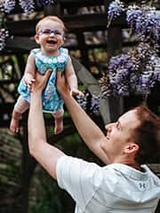Shwachman-Diamond Syndrome: Elizabeth’s Story
Shwachman-Diamond Syndrome: Elizabeth’s Story
Before Elizabeth was born, there had already been indications that she would have unique health challenges. When she was just 6 weeks old, she was diagnosed with a rare condition called Shwachman-Diamond syndrome. She has large care teams of specialists both near her home in Northern Virginia and at Children's Hospital of Philadelphia’s (CHOP) Comprehensive Bone Marrow Failure Center, who collaborate to keep her growing and overcoming the condition’s challenges.

Doctors raised red flags during Michelle’s pregnancy with Elizabeth, following her closely and performing a variety of tests, including genetic and chromosome testing, throughout the pregnancy but with inconclusive results. Michelle’s team monitored her multiple times a week at the hospital, encouraging her to not travel far and to prepare for anything.
Elizabeth was born weighing 5 pounds and was taken to the newborn intensive care unit. At just 36 hours old, she began undergoing the testing that would continue for the next several weeks of her life. “They did X-rays at 36 hours old to look at her bones and her size,” says her father, Griffin. “They did progressively more complex genetic tests for the next six weeks.”
Elizabeth had trouble gaining weight. “She lost weight in the NICU, and getting back to 5 pounds was a challenge, then getting to 6,” says Griffin. “Every ounce was a lot of work.”
“We had teams of doctors doing testing and clinical diagnoses, trying to connect the dots,” Michelle recalls. One clinical possibility was that Elizabeth had a rare disorder that causes bones to grow abnormally and become overly dense. Pursuing that idea, in February 2020 — just before the beginning of the COVID-19 pandemic — the family traveled to a hospital in the Midwest that specializes in skeletal disorders, and there was discussion of Elizabeth undergoing a bone marrow transplant.
Genome sequencing reveals the diagnosis
More About Shwachman-Diamond Syndrome
One week before beginning the bone marrow transplant, the geneticist from Inova Fairfax Hospital called with the results of Elizabeth’s complete genome sequencing, the process of determining the entirety of a person’s DNA sequence. The diagnosis was a rare condition, so it was not on any previous testing panel: Shwachman-Diamond syndrome (SDS). This triggered a referral to pediatric hematologist/oncologist Robin Dulman, MD, at Inova Pediatric Specialists of Virginia in Fairfax, Va.

“We did a 180-degree shift and learned everything we could about SDS,” says Griffin. A rare condition caused by a gene mutation, SDS is characterized by bone marrow failure, a low number of white blood cells, pancreatic insufficiency, skeletal abnormalities, issues with the immune system, poor growth due to difficulty absorbing food, and, in some cases, neuro-developmental issues.
With a confirmed diagnosis, the geneticist gave Michelle and Griffin a list of specialty centers for this rare disease, “We learned that CHOP has an incredible bone marrow failure program,” says Griffin. They were encouraged by the fact that Peter Kurre, MD, Director of CHOP’s Pediatric Comprehensive Bone Marrow Failure Center, specifically lists SDS as one of the conditions he specializes in.
Coordinated care is ‘life-changing’
In coordination with Dr. Dulman, Elizabeth was first seen at CHOP when she was a few months old. “Unfortunately, SDS affects various parts of the body,” says Michelle, “so we have a large team: hematology, immunology, gastroenterology, endocrinology, multiple therapists and more — both locally and at CHOP. This is in addition to frequent pediatrician visits. The power of this partnership and the holistic care they provide our daughter has been life-changing, especially as travel with an immunocompromised child during the pandemic has been challenging.”
The management of SDS is directed toward the specific symptoms that affect each individual. Now a little bit older than 2, Elizabeth has been growing on her own curve, thanks to a regimen of pancreatic enzymes before every meal and dietary supplements. Her liver function is monitored. Because SDS increases the risk of blood disorders such as leukemia and other disorders, she is tested often by a hematologist/oncologist, and she has yearly bone marrow biopsies to determine the condition of her marrow. Immunology monitors weekly infusions to support her poor immune system and infection-fighting cells.

“It's been a very holistic approach at CHOP,” Michelle explains. “They support early-intervention therapies for Elizabeth since developmental delays and learning difficulties are seen in many SDS patients. They even connected me and Griffin with the Shwachman-Diamond Syndrome Foundation — their family support has been an incredible lifeline for us, and we’ve been able to participate in their fundraising projects for SDS research in pursuit of better treatments and hopefully an ultimate cure for SDS.”
“We’re focused on maintaining and managing her health,” says Griffin. “We try to stay the course and keep her happy and growing. At some point, her bone marrow will fail. We’ll begin that process of a bone marrow transplant when it does.” For now, Michelle and Griffin have one mission when it comes to Elizabeth: “We’re focused on letting her be the happy 2-year-old that she is.”
Michelle says:
“We are so grateful Elizabeth has access to holistic care teams near and far that are not only focused on her health but also her possibilities and her happiness.”
“She has overcome so much in her two years, and has grown into the sweetest, happiest little girl who loves her family, cousins and friends so much. She loves dancing, reading books and running around the neighborhood to wave at every neighbor, dog and flower that she sees,” says Michelle.